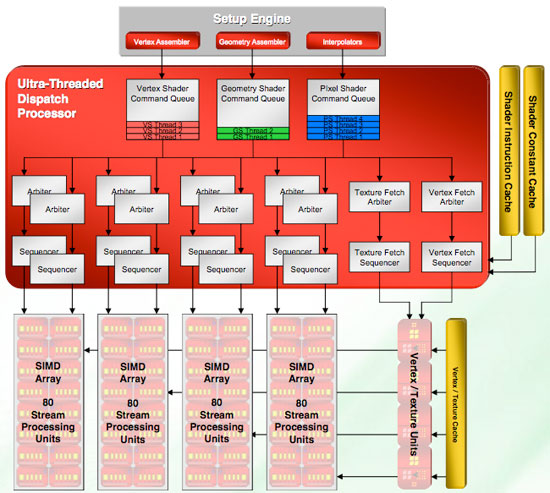ATI Radeon HD 2900 XT: Calling a Spade a Spade
by Derek Wilson on May 14, 2007 12:04 PM EST- Posted in
- GPUs
Texturing, Caches, and Memory
Texturing
R600 features less texture hardware than we would expect to see, though AMD stands by the argument that compute power will come out on top when it matters. At the same time, we can't compute anything if we don't have any data to work with. So let's take a look at what AMD has done with their texture units.
There are four texture units in R600, one for each SIMD unit. These units don't share resources with the hardware in the SIMD units and are independently scheduled by AMD's dispatch processor. The dispatch processor is able to determine what data will be needed for threads about to execute and can handle setting up the texture units without waiting for the SIMD unit to request data and come up empty.

Texture units on the R600 are able to make both filtered and unfiltered texture requests no matter what shader is running. Unfiltered textures are useful with non-image-based texture data like vertex textures, normal maps, and generic blocks of data. Filtered requests will generally be for image data to be used in determining the color of a pixel. R600 can address one unfiltered texture per clock per texture unit and one filtered textures per clock per texture unit. Filtered units can be used to request unfiltered textures if necessary, providing an extra four unfiltered textures in place of one filtered texture.
The unfiltered texture requests will come back through four fp32 texture samplers (one per component), while the filtered requests will return 16 data points which will be run through the texture filtering hardware resulting in four filtered texture samples. The hardware can at best produce 32 single component fp16 unfiltered results per texture unit per clock. More practically, each texture unit can produce four bilinear filtered four component fp16 samples per clock alongside four unfiltered results. For textures with fp32 components, two clocks would be required to complete a bilinear filter process, as only half the data is loaded at a time to conserve bandwidth.
This is definitely a step up for R600, as R5xx hardware doesn't have texture filtering hardware for floating point textures. All told, with each of its four texture units working, R600 can consume up to 32 unfiltered textures or 16 unfiltered textures plus 16 filtered textures (as long as they're fp16 or fewer bits and we're only using bilinear filtering).
G80 is built with four texture address units and eight texture filters per block of 16 SPs. In total, this means NVIDIA's hardware can produce 32 filtered texture samples per clock (again these are fp16 and bilinear filtered). Of course, NVIDIA is operating on twice as many threads per clock, so it is conceivable that they would benefit more from having the extra filtered data.
We will have to wait and see if AMD's approach of providing unfiltered and filtered texture access in parallel pays off. For the general case on pixel shaders, we would want to see more filtered textures per clock, but with vertex and geometry shaders coming into the mix this could be a good way to save hardware space while offering more texturing power. On a final texturing note, AMD implemented "percentage closer" filter hardware for depth stencil textures. This will allow developers to implement fast soft shadows. The details of the implementation weren't indicated though.










86 Comments
View All Comments
imaheadcase - Tuesday, May 15, 2007 - link
Says who? Most people I know don't care to turn on AA since they visually can't see a difference. Only people who are picky about everything they see do normally, the majority of people don't notice "jaggies" since the brain fixes it for you when you play.
Roy2001 - Tuesday, May 15, 2007 - link
Says who? Most people I know don't care to turn on AA since they visually can't see a difference.------------------------------------------
Wow, I never turn it of once I am used to have AA. I cannot play games anymore without AA.
Amuro - Tuesday, May 15, 2007 - link
Says who? No one spent $400 on a video card would turn off AA.
SiliconDoc - Wednesday, July 8, 2009 - link
Boy we'd sure love to hear those red fans claiming they turn off AA nowadays and it doesn't matter.LOL
It's just amazing how thick it gets.
imaheadcase - Tuesday, May 15, 2007 - link
Sure they do, because its a small "tweak" with a performance hit. I say who spends $400 on a video card to remove "jaggies" when they are not noticeable in the first place to most people. Same reason most people don't go for SLI or Crossfire, because it really in the end offers nothing substantial for most people who play games.
Some might like it, but they would not miss it if they stopped using it for some time. Its not like its make or break feature of a video card.
motiv8 - Tuesday, May 15, 2007 - link
Depends on the game or player tbh.I play within ladders without AA turned on, but for games like oblivion I would use AA. Depends on your needs at the time.